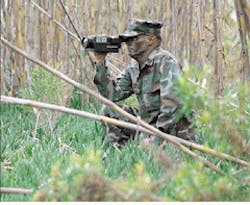CONFERENCE PREVIEW: AeroSense '96 puts the focus on IR technology
The Tenth Annual SPIE AeroSense Symposium (April 8-12, Orlando, FL) for remote sensing boasts new conferences, an international exhibit, and technical papers from all over the world. The exhibit will include a Russian Technology Pavilion and a Florida Electro-Optics Pavilion. The conference will feature expanded conferences on infrared sensors and technology, including Infrared Technology XXII, a conference that has traditionally been held at the SPIE Annual Meeting. 1996 is also the "on" year for biennial conferences on infrared (IR) focal-plane arrays and readout electronics.
Among the new conferences at AeroSense are those covering electro-optical technology for remote chemical detection and environmental monitoring, control of unmanned vehicles, and algorithms for multispectral and hyperspectral imaging data analysis, a nontrivial task by any standards. However, in 1996, conferences in imaging spectrometry instrumentation and applications, as well as astronomical applications will be relocated from AeroSense to the SPIE Annual Meeting in August (Denver, CO).
Infrared technology
"Exciting things are taking place in infrared focal-plane technologies these days," observes Infrared Technology and Applications cochair Björn Andresen. K Maruyama of Fujitsu Laboratories in Japan will report on the direct (MOVPE) growth of mercury cadmium telluride (HgCdTe) on silicon substrates (paper #2744-03). The work is designed to eliminate the thermal expansion mismatch between the HgCdTe detector material and the signal-readout-layer material, resulting in larger two-dimensional arrays of HgCdTe detectors for the 8- to 11-µm region.
The performance of quantum-well infrared photodetectors (QWIPs) has a direct effect on these devices. T. Faska and W. Beck from Lockheed Martin Laboratories (Baltimore, MD) will discuss the current status of quantum-well focal-plane arrays in paper #2744-23. A state-of-the-art example of the technology is a 9-µm-cutoff 256 × 256 QWIP focal-plane-array camera reported by S. Gunpala of the Jet Propulsion Laboratory (Pasadena, CA; paper #2746-11).
Uncooled focal-plane arrays will make a strong showing at AeroSense. A new approach for IR detectors incorporating ferroelectric material in pyroelectric detectors is reported by researchers at Donnelly Optics (Tucson, AZ; paper #2746-07). In paper #2744-55, scientists from GEC-Marconi Sensors Ltd. (Basildon, Essex, England) and Cairns Ltd. (Canvey Is., Essex, England) present an uncooled IR RPA camera for use in firefighting applications.
On the exhibit floor, lightweight IR cameras produced by Amber (Goleta, CA,), Mitsubishi, and Nikon demonstrate the steady commercial penetration of uncooled focal-plane technology (see photo). "Uncooled detectors allow you to produce systems at a reasonable price," observes IR Detectors and Focal Plane Arrays cochair Eustace Dereniak. "Once you get away from the cost issue you can expand the applications."
The focus on IR technology continues in the form of laser radar. Despite the fact that last year`s conference on laser radar technology and applications is a biennial event, it returns in 1996. Says conference chair Gary Kamerman, "There was enough work getting ready to break last year that we decided to go ahead and run the conference this year as well." Kamerman also discusses conference highlights in his laser-radar feature in this issue.
Other highlights include the use of laser radar for topographical mapping of Eros in the Near Earth Asteroid Rendezvous (NEAR; paper #2748-13) and new hardware approaches. By incorporating a processor chip that is bump-bonded directly behind the detector array, Richard Richmond and colleagues at Wright-Patterson AFB, OH, have developed a laser-radar system that captures a complete three-dimensional angle-angle-range image with a single pulse (paper #2748-05). The sensor provides separate independent range-finder circuitry for each pixel, allowing serial readout of captured time-of-flight data.
Optical processing
By combining digital signal-processing techniques with optical methods, researchers have obtained performance that exceeds anything either technique could do alone. An acousto-optic device developed by researchers at the University of Colorado (Boulder, CO) incorporates simultaneous use of parallel tangents and beam steering and offers a wide angular aperture, wide bandwidth, and high diffraction efficiency (paper #2754-12).
Essex Corp. (Columbia, MD) re searchers will discuss their ImSyn optical processor, a device that uses amplitude and phase information (paper #2754-18) to design filters for increased detection over a broader range of image variables, such as aspect angle, image scale, and rotation, and offers increased rejection of clutter. With high dynamic range, accuracy, and throughput, the system has applications in image processing, biomedical imaging (such as MRI and CAT scans), and nondestructive testing. These papers provide examples of the trend toward commercialization of this technology.
AeroSense also features novel applications and developments in optical components, such as a new type of polarizer based on a diffraction grating applied to a birefringent substrate, developed by researchers at the Chinese Academy of Sciences (Beijing, China; paper #2749-01). The combination of double refraction in the material and diffraction by the grating separates an incident beam into two polarized beams (ordinary and extraordinary), yielding high extinction ratios, high damage thresholds, and large beamsplitting angles in an economical device.
About the Author
Kristin Lewotsky
Associate Editor (1994-1997)
Kristin Lewotsky was an associate editor for Laser Focus World from December 1994 through November 1997.
